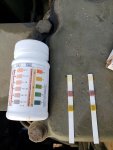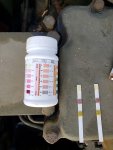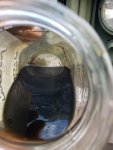Following advice given here, I performed a coolant test today, using test strips. The kit says it measures freeze point, nitrites and Ph.
I opened the drain cock at the bottom of the radiator and a pure black fluid resembling engine oil drained out. After swearing a few choice words, I calmed down and examined it more closely.
So, with all that, is this just some sort of sediment or sludge in the bottom of the radiator or do I have a bigger problem?
Now onto the test strip results-
The patch at the top indicates nitrites. This patch read very weak, indicating "charge." This means I need to add SCA?
The middle patch indicates freeze point. This patch seemed to indicate "50" or -37F degrees protection.
The lower patch indicates Ph. This patch looks closer to 8.0 than 7.0, which is squarely in the middle. Not great, but shouldn't be attacking my cylinder liners, right?
Comments on the radiator sludge and the test strip results, please.
I opened the drain cock at the bottom of the radiator and a pure black fluid resembling engine oil drained out. After swearing a few choice words, I calmed down and examined it more closely.
- It doesn't smell like engine oil
- I don't *think* engine oil settles in the bottom of circulated coolant. Contaminated coolant usually has a milkshake appearance. This does not.
- Swirling it around, it appears to be a black sediment in suspension. The fluid is much thinner than diesel engine oil.
- The engine oil level is normal, just below "F" on the dipstick. The oil color is pure black, not milky in appearance and smells like normal oil.
- I have been running the engine daily, which would circulate coolant and oil.
- Oil pressure is around 80psi when cold.
- Exhaust looks normal, no white clouds...or really any cloud at all. Just a little black.
- Coolant in the surge tank is normal in appearance, lacking the black color that was sampled from the bottom of the radiator.
So, with all that, is this just some sort of sediment or sludge in the bottom of the radiator or do I have a bigger problem?
Now onto the test strip results-
The patch at the top indicates nitrites. This patch read very weak, indicating "charge." This means I need to add SCA?
The middle patch indicates freeze point. This patch seemed to indicate "50" or -37F degrees protection.
The lower patch indicates Ph. This patch looks closer to 8.0 than 7.0, which is squarely in the middle. Not great, but shouldn't be attacking my cylinder liners, right?
Comments on the radiator sludge and the test strip results, please.
Attachments
-
118.6 KB Views: 16
-
110.9 KB Views: 16
-
90.9 KB Views: 33




